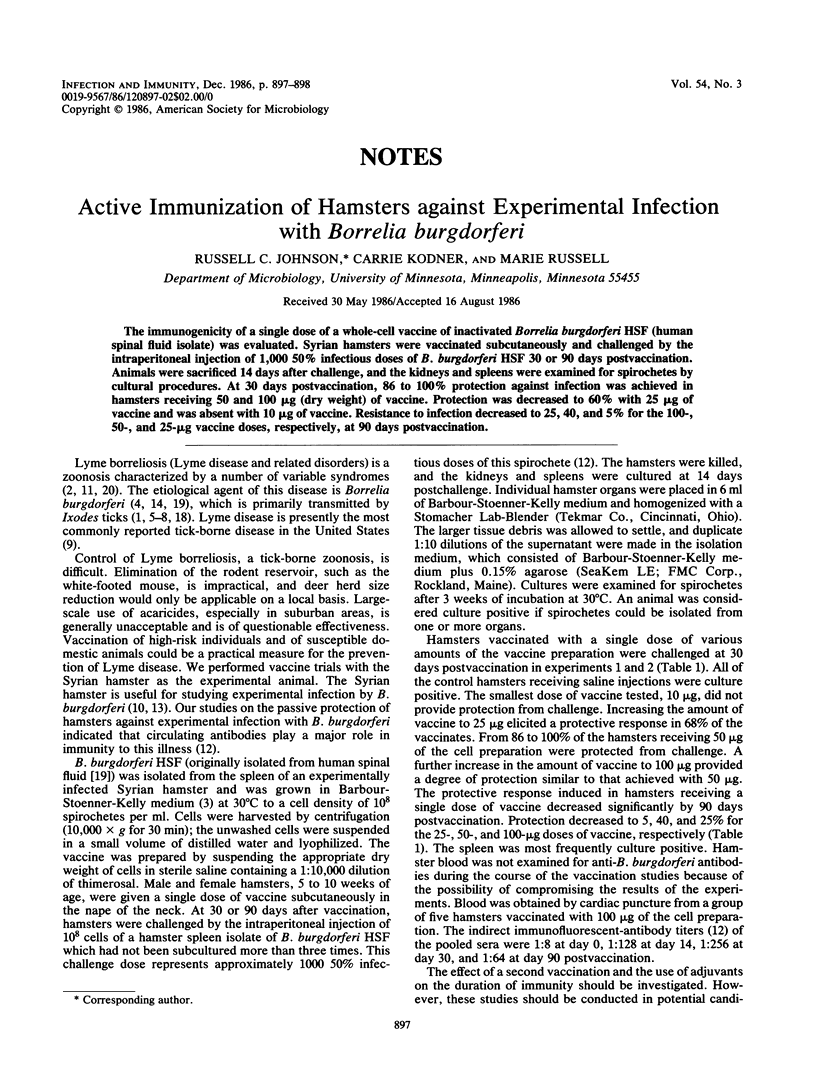Abstract
The immunogenicity of a single dose of a whole-cell vaccine of inactivated Borrelia burgdorferi HSF (human spinal fluid isolate) was evaluated. Syrian hamsters were vaccinated subcutaneously and challenged by the intraperitoneal injection of 1,000 50% infectious doses of B. burgdorferi HSF 30 or 90 days postvaccination. Animals were sacrificed 14 days after challenge, and the kidneys and spleens were examined for spirochetes by cultural procedures. At 30 days postvaccination, 86 to 100% protection against infection was achieved in hamsters receiving 50 and 100 micrograms (dry weight) of vaccine. Protection was decreased to 60% with 25 micrograms of vaccine and was absent with 10 micrograms of vaccine. Resistance to infection decreased to 25, 40, and 5% for the 100-, 50-, and 25-micrograms vaccine doses, respectively, at 90 days postvaccination.
Full text
PDF

Selected References
These references are in PubMed. This may not be the complete list of references from this article.
- Anderson J. F., Magnarelli L. A., Burgdorfer W., Barbour A. G. Spirochetes in Ixodes dammini and mammals from Connecticut. Am J Trop Med Hyg. 1983 Jul;32(4):818–824. doi: 10.4269/ajtmh.1983.32.818. [DOI] [PubMed] [Google Scholar]
- Benach J. L., Bosler E. M., Hanrahan J. P., Coleman J. L., Habicht G. S., Bast T. F., Cameron D. J., Ziegler J. L., Barbour A. G., Burgdorfer W. Spirochetes isolated from the blood of two patients with Lyme disease. N Engl J Med. 1983 Mar 31;308(13):740–742. doi: 10.1056/NEJM198303313081302. [DOI] [PubMed] [Google Scholar]
- Bosler E. M., Coleman J. L., Benach J. L., Massey D. A., Hanrahan J. P., Burgdorfer W., Barbour A. G. Natural Distribution of the Ixodes dammini spirochete. Science. 1983 Apr 15;220(4594):321–322. doi: 10.1126/science.6836274. [DOI] [PubMed] [Google Scholar]
- Burgdorfer W., Barbour A. G., Hayes S. F., Benach J. L., Grunwaldt E., Davis J. P. Lyme disease-a tick-borne spirochetosis? Science. 1982 Jun 18;216(4552):1317–1319. doi: 10.1126/science.7043737. [DOI] [PubMed] [Google Scholar]
- Burgdorfer W., Barbour A. G., Hayes S. F., Péter O., Aeschlimann A. Erythema chronicum migrans--a tickborne spirochetosis. Acta Trop. 1983 Mar;40(1):79–83. [PubMed] [Google Scholar]
- Burgdorfer W., Lane R. S., Barbour A. G., Gresbrink R. A., Anderson J. R. The western black-legged tick, Ixodes pacificus: a vector of Borrelia burgdorferi. Am J Trop Med Hyg. 1985 Sep;34(5):925–930. doi: 10.4269/ajtmh.1985.34.925. [DOI] [PubMed] [Google Scholar]
- Duray P. H., Johnson R. C. The histopathology of experimentally infected hamsters with the Lyme disease spirochete, Borrelia burgdorferi. Proc Soc Exp Biol Med. 1986 Feb;181(2):263–269. doi: 10.3181/00379727-181-42251. [DOI] [PubMed] [Google Scholar]
- Johnson R. C., Kodner C., Russell M. Passive immunization of hamsters against experimental infection with the Lyme disease spirochete. Infect Immun. 1986 Sep;53(3):713–714. doi: 10.1128/iai.53.3.713-714.1986. [DOI] [PMC free article] [PubMed] [Google Scholar]
- Johnson R. C., Marek N., Kodner C. Infection of Syrian hamsters with Lyme disease spirochetes. J Clin Microbiol. 1984 Dec;20(6):1099–1101. doi: 10.1128/jcm.20.6.1099-1101.1984. [DOI] [PMC free article] [PubMed] [Google Scholar]
- Kornblatt A. N., Urband P. H., Steere A. C. Arthritis caused by Borrelia burgdorferi in dogs. J Am Vet Med Assoc. 1985 May 1;186(9):960–964. [PubMed] [Google Scholar]
- Lissman B. A., Bosler E. M., Camay H., Ormiston B. G., Benach J. L. Spirochete-associated arthritis (Lyme disease) in a dog. J Am Vet Med Assoc. 1984 Jul 15;185(2):219–220. [PubMed] [Google Scholar]
- Magnarelli L. A., Anderson J. F., Kaufmann A. F., Lieberman L. L., Whitney G. D. Borreliosis in dogs from southern Connecticut. J Am Vet Med Assoc. 1985 May 1;186(9):955–959. [PubMed] [Google Scholar]
- Spielman A., Wilson M. L., Levine J. F., Piesman J. Ecology of Ixodes dammini-borne human babesiosis and Lyme disease. Annu Rev Entomol. 1985;30:439–460. doi: 10.1146/annurev.en.30.010185.002255. [DOI] [PubMed] [Google Scholar]
- Steere A. C., Grodzicki R. L., Kornblatt A. N., Craft J. E., Barbour A. G., Burgdorfer W., Schmid G. P., Johnson E., Malawista S. E. The spirochetal etiology of Lyme disease. N Engl J Med. 1983 Mar 31;308(13):733–740. doi: 10.1056/NEJM198303313081301. [DOI] [PubMed] [Google Scholar]
- Steere A. C., Malawista S. E., Hardin J. A., Ruddy S., Askenase W., Andiman W. A. Erythema chronicum migrans and Lyme arthritis. The enlarging clinical spectrum. Ann Intern Med. 1977 Jun;86(6):685–698. doi: 10.7326/0003-4819-86-6-685. [DOI] [PubMed] [Google Scholar]


